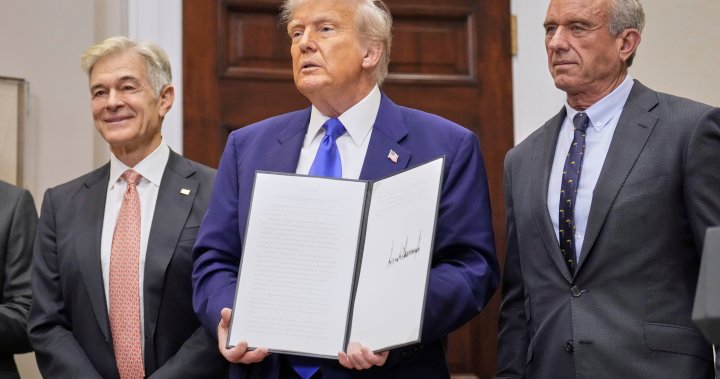U.S. President Donald Trump has launched a new effort to lower prescription drug prices for Americans that targets foreign nations — both for the lower prices they pay and the potential to import cheaper drugs from those countries.
Yet the federal government and policy experts say any potential impacts from the executive order signed this week — including supply shortages and higher prices — aren’t likely to hit Canada.
“I don’t think this is actually likely to be a direct threat against Canada,” said Michael Law, a professor at the University of British Columbia and the Canada Research Chair in access to medicines.
Trump’s order calls on the health department, led by Robert F. Kennedy Jr., to broker new price tags for drugs over the next month.
If deals are not reached with the drugmakers, Kennedy will be tasked with developing a new rule that ties the price the U.S. pays for medications to lower prices paid by other countries.
“We’re going to equalize,” Trump said at a Monday press conference. “The rest of the world is going to have to pay a little bit more, and America is going to pay a lot less.”

In Canada, drug prices are overseen by the Patented Medicine Prices Review Board, which told Global News it protects Canadian consumers by reviewing prices and ensuring they’re not “excessive.”
“If the price of a patented medicine is found to be excessive by a Hearing Panel, the Board has the power to order a reduction in the price in the price to a non-excessive level and to enforce that order,” a spokesperson said in an email. “The Board is also able to order a rights holder to offset any excess revenues.”
The spokesperson added the review board receives publicly-available prices for drugs sold in 11 “comparator” countries — including Germany, the United Kingdom, Australia and Sweden — that factor into prices set in Canada.
“Since the U.S. is not in this basket of comparator countries, the (board’s) price review would not be directly affected by price changes in the U.S.,” the emailed statement said.
Regulatory agencies like the Patented Medicine Prices Review Board and the pan-Canadian Pharmaceutical Alliance, which negotiates prices with drugmakers on behalf of provincial, territorial and federal health insurance plans, are generally why drug costs in Canada are lower than the U.S., experts say. Dozens of other countries have similar national regulators.
According to experts who spoke with the Associated Press after Trump’s announcement, the U.S. drug market mostly operates as a fragmented system where companies negotiate with individual insurers or pharmacy benefit managers, commonly known as PBMs.

Get weekly health news
Receive the latest medical news and health information delivered to you every Sunday.
In countries with single regulatory agencies, a drug company can lose out on profits entirely if a regulator walks away from negotiations, and is more likely to accept a lower price than no deal at all.
The U.S. Congress in 2022 passed a new law that allows Medicare to negotiate lower prices for a handful of prescription drugs starting in 2026, primarily insulin for diabetes patients.
A 2024 report published by the RAND research organization found, using 2022 data, that prices in the U.S. were 2.78 times higher than those in 33 comparable countries across all drugs. That includes Canada, where drug prices were just 44 per cent of U.S. prices, according to the report.
Trump also threatened pharmaceutical companies with federal investigations into their practices and opening up the U.S. drug market to bring in more imported medications from abroad if prices aren’t lowered.
Law said pharmaceutical companies would likely not allow that to happen on a national scale.
“I find it highly unlikely that any branded company in the United States is going to cut their margins by sending an enormous amount of drugs to Canada, only to have it come back into the United States at a lower price,” he said.
“It’d be very easy for the companies to limit the extent to which that activity could take place.”

Canada also doesn’t have the manufacturing capacity to fulfill mass imports to the U.S. while also fulfilling domestic orders, Law said.
Individual states have sought to source cheaper drugs from Canada for decades.
In 2024, Florida became the first state to get a drug importation program approved by the U.S. Food and Drug Administration (FDA) under federal law.
More than a year later, however, the program has yet to begin and no drugs have been imported to Florida from Canada.
Under federal requirements, state officials must first test the drugs to make sure they’re authentic and relabel them so that they comply with U.S. standards.
Trump in April signed an executive order on lowering drug costs that directed Kennedy to, among other things, “streamline and improve” within 90 days the program allowing states to import drug from Canada.
Colorado has said it expects its own Canadian drug import program to be approved by the FDA soon, and other states have submitted applications as well.
Health Canada says it has been “taking all necessary action to safeguard the drug supply and ensure Canadians have access to the prescription drugs they need” ever since the Florida program was approved.
A spokesperson said the department has reminded drugmakers and exporters of its obligations under Canada’s Food and Drug Regulations, which prohibits the sale of certain drugs intended for the Canadian market outside Canada “if that sale would cause or worsen a drug shortage in Canada.”
“Health Canada will not hesitate to take immediate action to address non-compliance,” the spokesperson said in an emailed statement.
What could happen next with tariffs?
Trump has also vowed to impose tariffs on pharmaceuticals from foreign countries.
The U.S. Commerce Department last month launched a Section 232 investigation into whether those imports pose a national security threat — the same process that led to tariffs on steel and aluminum.
The department did not respond to questions from Global News about whether FDA-approved state drug importation programs would conflict with that investigation or future tariffs.
An FDA spokesperson, speaking on background, told Global News in an email that the agency “is committed to implementing the executive orders related to drug imports.”

A majority of pharmaceutical ingredients used in drugs sold in North America originate from India and China, meaning tariffs on pharmaceuticals could raise prices for Americans.
Law said it’s possible Indian and Chinese manufacturers facing tariffs could also pass those added costs to Canadian customers, but only if those drugs are being imported from the U.S.
“Especially for generic drugs, India manufactures the majority of the drugs that are sold in the world,” he said.
“If those drugs are getting directly imported from India to Canada, the U.S. tariffs would have little to no impact whatsoever on those products.”
—with files from Global’s Katie Dangerfield and the Associated Press
Trump wants to ‘equalize’ and lower drug prices. Could Canada be impacted?





